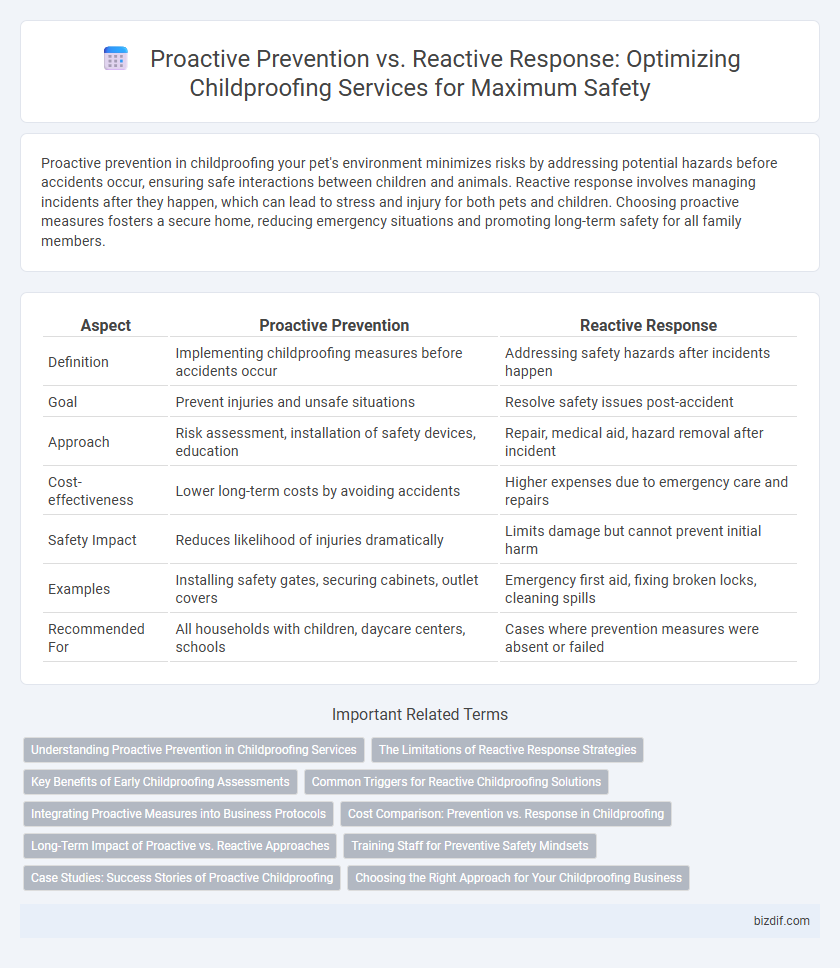Proactive prevention in childproofing your pet's environment minimizes risks by addressing potential hazards before accidents occur, ensuring safe interactions between children and animals. Reactive response involves managing incidents after they happen, which can lead to stress and injury for both pets and children. Choosing proactive measures fosters a secure home, reducing emergency situations and promoting long-term safety for all family members.
Table of Comparison
| Aspect | Proactive Prevention | Reactive Response |
|---|---|---|
| Definition | Implementing childproofing measures before accidents occur | Addressing safety hazards after incidents happen |
| Goal | Prevent injuries and unsafe situations | Resolve safety issues post-accident |
| Approach | Risk assessment, installation of safety devices, education | Repair, medical aid, hazard removal after incident |
| Cost-effectiveness | Lower long-term costs by avoiding accidents | Higher expenses due to emergency care and repairs |
| Safety Impact | Reduces likelihood of injuries dramatically | Limits damage but cannot prevent initial harm |
| Examples | Installing safety gates, securing cabinets, outlet covers | Emergency first aid, fixing broken locks, cleaning spills |
| Recommended For | All households with children, daycare centers, schools | Cases where prevention measures were absent or failed |
Understanding Proactive Prevention in Childproofing Services
Proactive prevention in childproofing services involves identifying potential hazards before accidents occur, minimizing risks through strategic modifications in the home environment. Experts conduct thorough assessments to safeguard areas like electrical outlets, sharp edges, and choking hazards, enhancing overall child safety. This approach reduces emergency incidents by maintaining continuous vigilance and adapting safety measures as children grow and develop new abilities.
The Limitations of Reactive Response Strategies
Reactive response strategies in childproofing often fail to address hazards before accidents occur, leaving children vulnerable to preventable injuries. These approaches rely on post-incident interventions rather than identifying and eliminating risks proactively. Relying solely on reactive measures can result in increased emergency situations, higher long-term costs, and compromised child safety.
Key Benefits of Early Childproofing Assessments
Early childproofing assessments identify potential hazards before incidents occur, significantly reducing the risk of accidents in the home. Proactive prevention enhances children's safety by addressing risks related to electrical outlets, sharp edges, and choking hazards. This approach saves time and money by minimizing emergency responses and medical costs associated with injuries.
Common Triggers for Reactive Childproofing Solutions
Common triggers for reactive childproofing solutions include accessible sharp objects, unsecured furniture, and exposed electrical outlets, which often lead to accidents requiring immediate intervention. Addressing these hazards quickly minimizes injury risks and creates a safer environment for children. Implementing tailored safety measures after incidents ensures targeted protection against recurring dangers.
Integrating Proactive Measures into Business Protocols
Integrating proactive childproofing measures into business protocols significantly reduces risks by identifying and eliminating hazards before incidents occur. Businesses implementing thorough safety audits, employee training, and regular equipment maintenance create safer environments that protect children and minimize liability. Consistent investment in prevention strategies enhances overall safety culture and operational efficiency.
Cost Comparison: Prevention vs. Response in Childproofing
Investing in childproofing services proactively reduces the likelihood of accidents, significantly lowering potential medical and emergency costs. Reactive responses to injuries often involve high expenses related to treatment, legal liability, and home repairs, far exceeding the initial prevention investment. Cost analysis consistently shows that prevention in childproofing is a more economical approach compared to the financial burden caused by addressing accidents after they occur.
Long-Term Impact of Proactive vs. Reactive Approaches
Proactive prevention in childproofing significantly reduces the risk of accidents by addressing hazards before they cause harm, ensuring a safer environment for children over time. Reactive response often involves costly medical treatments and repairs after incidents occur, leading to increased stress and long-term health implications. Investing in comprehensive childproofing strategies enhances overall safety, minimizes emergency interventions, and promotes sustained well-being for families.
Training Staff for Preventive Safety Mindsets
Training staff in proactive childproofing techniques significantly reduces the risk of accidents by instilling a preventive safety mindset that anticipates hazards before they occur. Emphasizing early hazard recognition, proper use of safety equipment, and consistent adherence to safety protocols enhances the overall effectiveness of childproofing services. A well-trained team fosters a safer environment by prioritizing prevention rather than relying on reactive responses to incidents.
Case Studies: Success Stories of Proactive Childproofing
Case studies highlight how proactive childproofing significantly reduces household accidents, with families implementing safety measures like securing furniture and installing outlet covers before incidents occur. Data from these success stories reveal a marked decrease in emergency room visits and injury-related hospitalizations among children in homes with comprehensive childproofing plans. These real-world examples demonstrate that investing in prevention leads to safer environments and peace of mind for parents and caregivers.
Choosing the Right Approach for Your Childproofing Business
Implementing proactive prevention strategies in your childproofing business significantly reduces risks and enhances client trust by addressing potential hazards before incidents occur. Reactive response methods often result in costly repairs and diminished customer satisfaction due to delayed intervention. Prioritizing proactive measures ensures a safer environment, optimizes operational efficiency, and establishes your business as a reliable leader in child safety solutions.
Proactive Prevention vs Reactive Response Infographic

 bizdif.com
bizdif.com